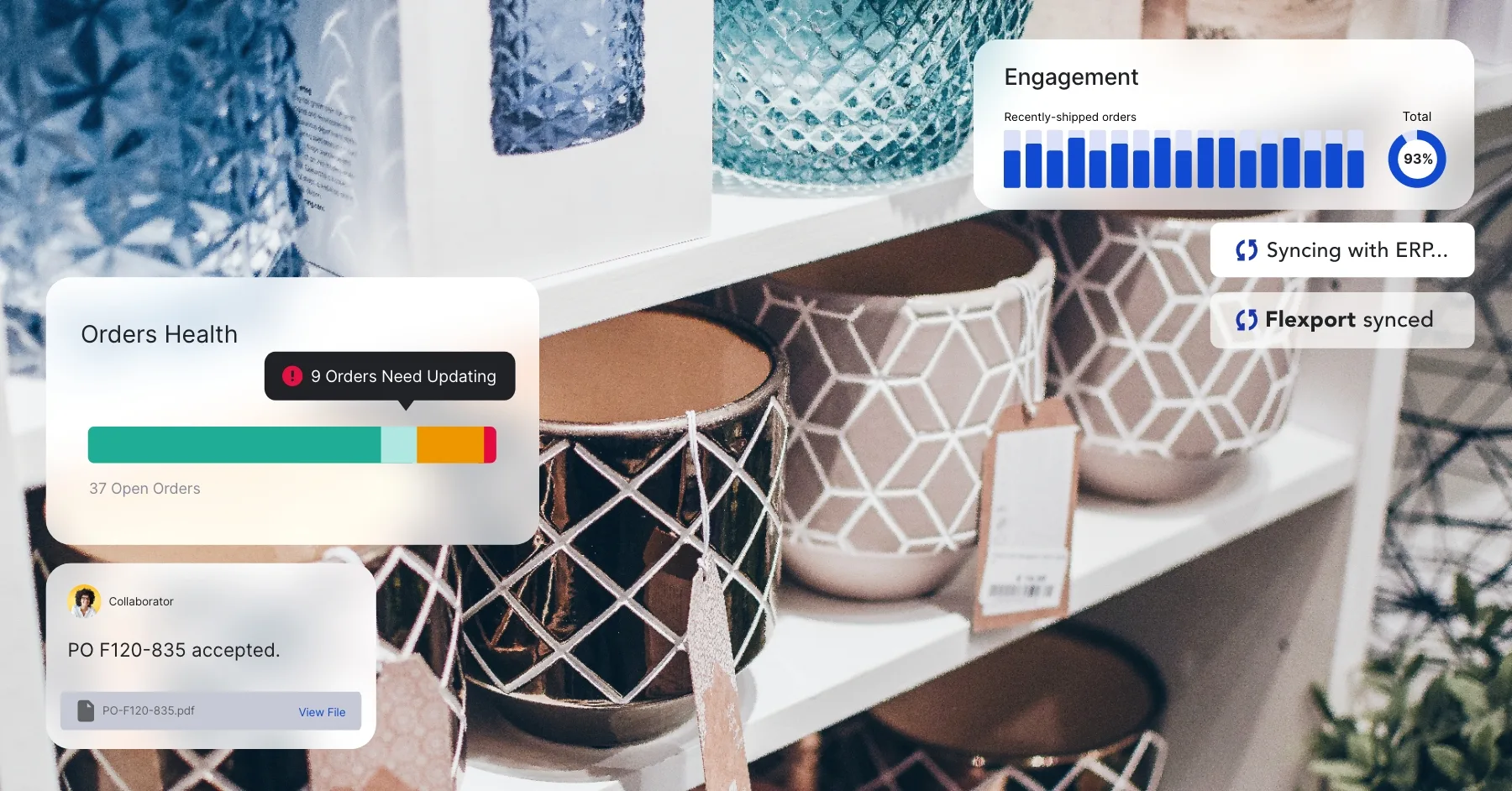The homegoods market, including the manufacturing, distribution, and retail of home furniture, cookware, gardening equipment, and home accessories— is projected to be worth $606.9 billion dollars by next year.
Statista reports that U.S. revenue in the furniture e-commerce market alone is forecasted to hit 16.6 billion U.S. dollars in 2028, fueled by in-store and online shopping for furniture and home decor, appliances, bedding, bath, and more.
Growing demand for products in the category means brands need to make sure that their homegoods supply chain operates efficiently despite continuing supply chain management issues and challenges.
What are some of these challenges? Our recent survey on The Current State of Supply Chain, encompassing over 600 consumer brands with revenues ranging from $15 million to $750 million, found that most brands expect material shortages, labor constraints, escalating fulfillment expenses, and other challenges from the past few years to endure this year.
Let’s dive into the primary supply chain hurdles facing home goods brands and how they can overcome them.
Top Supply Chain Management Issues and Challenges for Homegoods Brands:
1. Material Shortages
Material shortages in homegoods were at their worst in recent years, especially at the beginning of the pandemic in March 2020.
Manufacturers closed plants and trimmed capacity, and many trucking firms were hit with labor shortages. These shortages created delays, reduced supply, and led to further manufacturing and capacity shortages.
Because of these challenges, it wasn’t uncommon for consumers to wait 6-12 months to receive furniture once they placed an order because of shortages.
While the pandemic and its effects on the supply chain are now further behind us, homegoods brands still need to focus on being proactive rather than reactive if they want to keep products in stock and deliver them on time.
How To Overcome Material Shortages:
One unexpected way to better navigate shortages? Consistently track supplier performance to identify the most reliable suppliers and establish and maintain strong supplier relationships.
Homegoods brands can use supplier scorecards, for example, to evaluate supplier performance with metrics such as on-time delivery, product quality, lead time, supplier engagement rate, and compliance.
This helps homegoods brands make informed decisions about which suppliers they work with and how they communicate with them so that they can optimize their supply chain and reduce shortages and delays.
Some other tactics homegoods brands can use to handle material shortages include:
- Diversifying their supplier source.
- Improving supplier collaboration.
- Focusing on inventory management to identify potential shortages in advance.
- Monitoring trends and integrating supply chain automation to track POs.
2. Omnichannel Fulfillment
Like many other consumer goods brands, home brands often sell across multiple channels, including eCommerce, direct-to-consumer (DTC), and brick-and-mortar.
Many consumers shop online for homegoods, using tools like AI and VR to see what items will look like in their space.
However, they often want to physically see products in-store to evaluate the quality and how certain items will fit in their space. This is especially true when consumers are making larger purchases, like furniture, for example.
As a result, many consumers switch between purchasing items for their home online and in-store depending on the specific product they’re looking for.
Selling across multiple channels means brands must fulfill orders quickly and cost-effectively, regardless of whether they originate from traditional retailers, e-commerce platforms, or DTC channels.
However, this can be difficult when multiple fulfillment partners or third-party logistics (3PL) providers are part of their supply chain.
How to Overcome Omnichannel Fulfillment Challenges:
Brands should prioritize investments in fulfillment infrastructure, inventory visibility, and purchase order management systems to provide seamless order processing and delivery regardless of whether consumers purchase products online or in-store.
For many brands, this means investing in technology that streamlines and automates their fulfillment processes.
In fact, our recent State of Supply Chain survey found that more than a third of brands surveyed plan to implement more cost-effective routing, carrier selection, and freight consolidation strategies to drive more efficient logistics and transportation this year.
How? 40% of brands surveyed say they plan to invest in new technologies that streamline communication and drive better collaboration with suppliers and fulfillment teams.
Additionally, homegoods brands can leverage data analytics and machine learning algorithms to optimize inventory allocation and order routing, minimizing shipping costs and transit times.
3. Inventory Management
Home trends and demand can change rapidly, especially during peak seasons like holidays. Balancing inventory levels is crucial when product storage space is also often limited.
Overstocking can tie up valuable resources, while understocking can lead to missed sales.
How to Overcome Inventory Management Challenges:
By closely tracking stock levels and analyzing historical data, brands can identify potential shortages in advance and take proactive measures to address them.
Inventory management tools, for example, can help brands maintain accurate stock levels, track product movement, and optimize inventory to meet customer demands.
This also gives brands better visibility and control over inventory to avoid stockouts, reduce overstocking, and make better-informed purchasing decisions.
4. Sustainability Challenges
More consumers choose products for their homes based on how and where they are manufactured.
Therefore, brands that minimize waste or commit to fair labor practices and environmental protections throughout their supply chain differentiate themselves in a competitive landscape.
However, ensuring sustainable manufacturing and fair labor practices throughout the whole supply chain is challenging when multiple suppliers are involved.
While first-tier suppliers may commit to sustainable practices, it can be harder to guarantee that their suppliers also commit to the same practices.
Without this cascade of sustainable practices throughout the entire supply chain, brands risk lower-tier suppliers violating sustainability standards, damaging brand reputation, and negatively impacting sales.
How to Overcome Sustainability Challenges:
Homegoods brands should regularly evaluate new and existing providers for their labor and manufacturing practices and verify that their providers also follow good manufacturing practices.
Suppliers and providers should be able to show supporting documentation and certifications for their sustainability initiatives, which brands should be able to access easily.
They should also choose sustainable third-party logistics partners and suppliers who adopt environmentally friendly manufacturing processes that reduce carbon emissions.
Another way brands can increase sustainability and ethical sourcing? By using supply chain management tools that increase overall supply chain visibility.
5. Supply Chain Visibility
Supply chain visibility is crucial for homegoods brands to know when products will reach their destination and when they will be available to move on to the next step.
Complete visibility into the supply chain is also the only way brands can properly manage costs and other resources within their supply chain and make sure that each step of the PO process runs efficiently and effectively.
Where is visibility most important?
Brands included in our recent report identified inventory management, purchase order management, and supplier communication as some of the top areas in which they need more visibility in their supply chain.
How to Overcome Supply Chain Visibility Challenges:
To improve supply chain visibility, homegoods brands should analyze their current supply chain and identify areas where the top bottlenecks occur. This is the best way to prioritize which areas to focus on to see the most immediate improvements in overall supply chain efficiency.
It’s also crucial to remove siloed technology systems that don’t work well together.
Instead, brands can implement supply chain management technology that provides real-time access to critical information like purchase order progress, supplier communications, and other important documentation.
Real-time access to this critical information helps brands make faster, better-informed decisions throughout their supply chain.
Overcome Supply Chain Issues and Challenges with Anvyl
Anvyl connects global supply chain teams, systems, and suppliers to improve collaboration and decision-making from pre-PO issuance through to warehouse delivery— within a single system.
Our flexible tool facilitates real-time collaboration, automates key tasks and processes, and empowers teams with deeper insights that allow brands to make smarter decisions faster.
Schedule a demo to learn more about how Anvyl can help your brand overcome today’s supply chain challenges — and make sure your products reach consumers on time, on budget, every time.



